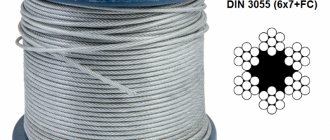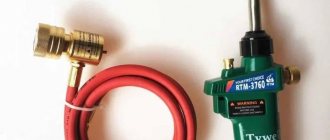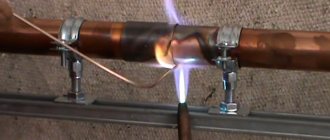Soldering steel products is technologically simple. For this, you can even use low-melting solders, for example, POS-61 or pure tin. For high-quality connection of steel parts into a single whole, it is recommended to tin the contact point with tin.
Subsequently, the following list of operations is performed:
Another popular way is to use tin as solder and machine oil as flux.
What is solder?
Solder is a mixture of low-melting metals that are capable of providing good contact between two surfaces, resulting from soldering. When heated, solder changes from a solid to a liquid state, which ensures spreading around the perimeter of the soldered part or at the point of their contact. In this case, fixation occurs at the molecular level due to a high degree of adhesion.
In terms of composition, solders can include a variety of components that provide them with the necessary performance properties. However, the vast majority consists of a mixture of lead and tin, the first of which provides hardness and refractoriness, and the second lightness and lowers the melting point. The composition may also contain other components: silver, nickel, zinc, copper, kobold, bismuth, antimony and others.
Due to the multi-component composition, the melting process also goes through several stages: first, the most fusible components are rarefied, while the refractory ones remain in the form of crystals at this moment. Then they melt, the mixture becomes homogeneous and ensures maximum filling and contact. However, fluxes are used in conjunction with solder to provide better filling and oxidation protection.
Release form
Solder comes in various forms. Initially, at the factory, these are pigs. The letter Ch is then added to the brand designation. For example, Ch POS-40. GOST 21930-76 determines the shape and size of pigs for each material and type.
Solder for retail sale comes in rods with a diameter of 8 mm, in the form of solder wire wound on a spool or rolled into a spiral and placed in a plastic tube.
Very often, soldering wire is a tube made of tin-lead alloy, inside of which there is flux - a substance that helps improve the quality of soldering.
Flux destroys the oxide film on the parts being soldered and prevents further oxidation of the soldered joint during its cooling.
Rosin, a product of the distillation of pine resin, is often used as a flux. It melts at a temperature of 68 ℃, under normal conditions it is hard, brittle, and yellow in color.
Classification
All criteria for classifying solders represent a rather broad area, which, perhaps, can only be done by highly specialized specialists. Therefore, to simplify the selection, specific brands are made for specific purposes - soldering aluminum, jewelry, copper wire, radio components, etc. The main thing you should pay attention to is the temperature parameter. Since, for example, soldering a microcircuit cannot be done with the same brand of PIC as the connection of cable cores, since the sensitive component may burn out and fail.
Solders for soldering are classified according to the following criteria:
- according to the method of supplying flux - flux-free and self-fluxing, for the former the flux is supplied separately, for the latter they contain it in their composition;
Rice. 1. Self-fluxing and with flux feed
- according to the main soldering element - tin solders, nickel, cobalt, manganese, titanium, silver, zirconium, vanadium, mixed, etc.
- according to the method of production - they are ready-made or formed directly during soldering;
- according to the solubility of components - there are completely melted and partially melted;
- by release form - tin wire, rod, ingots, sheet, granules, paste;
Solder release form
- by melting point - there are those that turn into a liquid state at low and high temperatures.
When choosing tin-lead solder, the most important criterion is the last one, so we will dwell on it in more detail.
Low-melting (soft).
Low-melting solders include those compositions that turn into a liquid state at temperatures from 145 to 400°C. But, at the same time, they provide relatively low strength; for low-melting alloys, the tensile strength is no more than 7 kg/mm2. The most common are tin-lead. Most often, soft solders are used in electronics for printed circuit boards or parts.
Refractory (hard).
Hard solders have significantly greater mechanical strength, but their melting point is more than 400°C, which is unacceptable for most radio components, since they can be damaged even if touched by a heated soldering iron tip. The two largest groups in this category are copper and silver compounds. Copper alloys are generally combined with zinc, but are too brittle and are therefore suitable for carbide alloys that only experience static loading. Silver solders are universal and can be used for soldering any connection points, however, the cost of these brands is also quite high.
Solder pastes.
Solder pastes are also a component for soldering radio components, but they are used for small elements made of low-melting metal. The paste composition contains crushed pieces of solder in a solution of liquid flux. They are used in those boards or devices where exposure to high temperatures can harm the equipment. Pastes are typically soldered with a hairdryer without an electric soldering iron, or can simply be applied as a conductive adhesive.
The soldering mixture is applied to the point where the leads are attached in batches and can be done using a special stencil, syringe or drop-jet cartridge.
Fig 3. Applying solder paste with a printer, syringe, stencil
However, the use of soldering paste imposes a number of requirements that must be met:
- before opening the container, be sure to keep it at room temperature for at least 2 hours; using means of forced solder heating for this is prohibited;
- after opening, the mixture must be mixed until a homogeneous substance is obtained, since during storage the flux can separate from the solder;
Rice. 4. Stir until a homogeneous mixture
- before application, the surface must be cleaned of possible impurities and contaminants; during long-term soldering, the procedure is repeated every 45 minutes;
- installation of electronic components in the applied paste must be carried out within 60 minutes, otherwise it will begin to lose its properties;
- after soldering, the remains and excess paste are washed off, there are those that can be washed off with plain water, others require a solvent, some may not be washed off.
The functional characteristics of such solder are extremely negatively affected by placement in an environment with high or low temperatures, as well as exposure to moisture.
Lead-free solders.
Initially, the reason for creating lead-free solder was the need to eliminate harmful effects on the environment and the human body. Such solders are widely used for soldering aluminum or steel in the food industry, for drinking water supply pipes, laboratory equipment and tools.
In total, there are three most common groups of lead-free solders:
- tin with copper - used for high-temperature soldering, refers to refractory solders, well suited for working on copper products;
- tin and silver - suitable for low-temperature soldering, provide better contact than lead solders, but they are expensive.
- tin with both copper and silver is also a soft option, which has a lower cost than the previous one and is practically in no way inferior to it in the quality of connections.
- tin with bismuth and silver - can be used for soldering copper at low temperatures;
- tin with zinc and bismuth is a cheaper version of the previous one, but has a number of difficulties in use.
Soldering components mounted through holes.
1. Install the component into the mounting holes, if necessary, bend the leads.
2. Apply the soldering iron tip in such a way that simultaneous contact is ensured with the mounting hole CP and the component lead, warm up for 0.5-1.0 s.
Struck No. 1.
It is necessary to ensure good thermal contact between the soldering iron tip and the soldered surfaces.
3. Apply a small amount of solder to the soldering iron tip so that a solder bridge is formed between the CP and the terminal (see figure).
4. Move the tubular solder in a circle along the CP in the opposite direction from the soldering iron tip (see figure).
5. Once the solder joint is formed, remove the solder rod.
6. At the same time, remove the soldering iron tip. To form the correct fillet shape, the soldering iron tip must move upward along the component lead.
Rule No. 2.
It is necessary to ensure contact between the soldering iron tip and the soldered surfaces until a solder fillet is formed.
Attention! Avoid applying strong pressure with the soldering iron tip to the gearbox. Do not allow the soldering iron tip to contact the solder fillet without using tubular solder, this may cause degradation of the solder joint.
Possible problems and solutions
Spattering.
High heating rate. Apply the solder rod to the heated contact surfaces (component terminal and CP), do not apply solder to the soldering iron tip.
Brushed solder joints.
Long-term contact of the soldering iron tip with the soldered joint after the solder rod is removed from the soldering zone.
Residues after soldering in the form of soot.
Clean the soldering iron tip and sponge or replace the soldering iron tip.
Excessive flux residue around the solder joint.
1. Large diameter tubular solder, use smaller diameter solder.
2. Excessive supply of tubular solder to the soldering point.
3. Low soldering temperature, use a higher power soldering iron or increase the soldering temperature.
Basic properties of solders
When choosing a specific brand of solder for soldering copper wires or aluminum alloys, you must be guided by their technical characteristics.
However, for all compositions a list of basic properties can be identified:
- wettability - shows how well the solder envelops and sticks to the parts being soldered;
- strength - determines the ability to withstand mechanical forces and loads; for this, boron, iron, nickel, zinc or cobalt can be added to the composition;
- plasticity - the ability to deform, achieved through additives from manganese, bismuth, lithium, etc.;
- resistance to high temperatures - important for soldering with hard alloys that are found in boiler rooms, furnaces, pipelines, heating devices, the property is achieved by adding tungsten, zirconium, vanadium, hafnium, niobium, etc.
- resistance to corrosion destruction - increases by alloying with copper or nickel.
Heating Methods
Soldering materials can be heated in different ways. If we talk about home use of the metal soldering process, the most common option is a soldering iron or torch.
The first tool is used if it is necessary to carry out a low-temperature process, the second - if a high-temperature one. The variety of modern soldering irons is great. Among them there are devices with automatic temperature control and other useful functions.
The production uses mainly other technologies: oven soldering, using induction heaters, immersion in special baths with metal or salts.
Electrical resistance heating is used, when the solder and the workpieces being connected are heated due to the flow of electric current through them, and others.
Criterias of choice
When choosing any composition for tinning copper parts or soldering wires, it is important to take into account a number of factors that will affect both the quality of work and the result obtained.
Among these criteria, first of all, pay attention to:
- types of elements to be connected, what material they are made of, their thickness and parameters of the surfaces to be connected;
- soldering method for which solder is selected - with a copper tip of a classic soldering iron, a hair dryer, a soldering station, etc.;
- permissible temperature regime - the melting temperature of the solder must be less than the melting temperature of the elements being connected;
- the presence of mechanical impact - determined by static or dynamic, possibly vibration;
- resistance to aggressive environments - for premature destruction of solder, its type must provide resistance to moisture, temperature, gases, dust and other factors affecting it during operation.
Most used brands
The most popular types are POS solders, they are based on lead and tin, marked POS-40, 60, 80, etc., here the numerical designation indicates the percentage of tin. They are produced, as a rule, in the form of soldering wire; depending on the percentage of the main components, they can be classified as either low-melting or high-melting grades.
Used for soldering copper, aluminum, brass, bronze and other metals:
- POS-90 – well suited for the food industry;
- POS-40 - used for pipes and parts made of brass, iron, etc.;
- POS-30 – in cable connections;
- POS-61 – for working with radio components.
Of the silver-containing grades, solders often found are PSr-15, 25.45, 65, 70; the number after the letter indicates the percentage of silver. This type covers both copper soldering in high-precision instruments and the medical field.
Rose alloy, also called POSV-50, is one of the solders with the lowest melting point - from 90 to 100 ° C. Used in jewelry, soldering printed circuit boards, for fuse links, etc.
Rice. 5. Alloy Rose
Characteristics of POS 61
POS-40 contains 40% tin, and POS-61 contains about 61% tin. Everything else is lead and additional impurities. By appearance you can determine what kind of solder you have in front of you. Matte and dark solder contains more lead. Light and shiny more than tin. This can best be seen in comparison.
With further heating, the more refractory metals in the alloy begin to melt. After they melt, the liquidus . After which the PIC solder is considered completely melted.
POS 40 consists of 39-41% tin, 59% lead. The remaining impurities are in the same ratio as in POS-10. POS-40 is usually used for soldering and tinning of radio equipment casings made of galvanized iron with galvanized seams.
The most famous of the solders are POS 10, POS 40, POS 61 and POS 90 (antimony-free solders). And POS containing antimony is called POSSU . The antimony content increases the strength of the solder by several percent.











